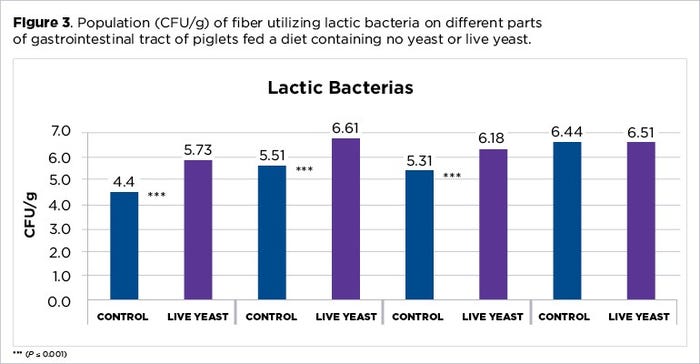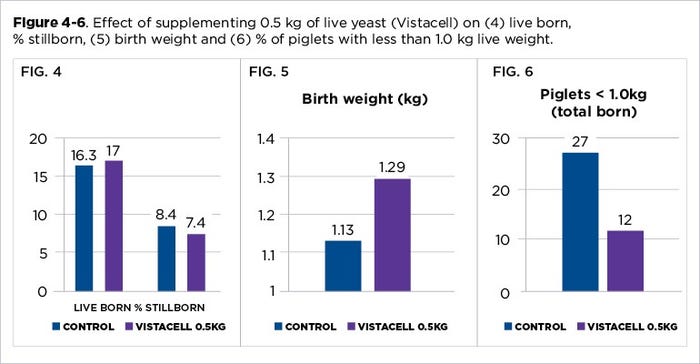Benefit of live yeast in diets fed to swine
Live Yeasts are Reported to Relieve Stress in Sows
April 15, 2022

Sponsored Content
To increase farm productivity, sows are being selected to produce more piglets per litter and ultimately are being asked to wean more piglets per sow per year (PSY). Increasing litter size generally increases parturition time and the number of piglets born later that are exposed to hypoxia. This increases the number of less viable piglets and stillborns. Furthermore, the prolificity of sows has increased while the individual weight of the piglet at birth has decreased, causing an increase in the variation of piglet size. Boulot et al. (2008) reported that average piglet birth weight is reduced by 100 g/pig for every extra pig above 9 piglets (9 piglets, 1.89 kg/piglet; 16 piglets, 1.38 kg/piglet). This can, in part, be explained by the limitation in uterus size, whereby a growing number of the developing fetuses are subjected to intra-uterine growth retardation (IUGR). The IUGR piglets now represent up to 30-40% of piglets in large litters. Longer farrowing time may also affect sow longevity, which is a key factor for the profitability of a commercial swine herd (Stalder et al., 2004). Since uterine capacity is limited, nutritional strategies must be adapted to mitigate the negative impacts of these physiological changes on sow longevity and lifetime performance of their progeny.
Live Yeast
Considering the beneficial effects on intestinal microbial balance, dietary administration of probiotics such are live yeasts are reported to relieve the stress of sows in gestation and lactation. Live yeasts are known for many beneficial health effects including antioxidant defense mechanisms, thereby ameliorating oxidative stress (Cai et al., 2014; Dowarah et al., 2016). Live yeasts are mostly active dry yeasts (typically Saccharomyces cerevisiae). Its effects depend on a combination of strain specificity and quantity of live yeast (CFU) surviving and performing in the right part of the gastro intestinal tract. In this sense, a live yeast that has been selected for high oxygen scavenging potential in addition to a product with a higher CFU concentration would be more beneficial as it would need less inclusion to achieve the target CFU number.
Pregnancy and lactation pose a considerable metabolic challenge for sows, particularly in highly prolific sows. The demand for energy increases with oxygen uptake, and increased release of stress hormones (glucocorticoids) associated with pregnancy and farrowing contributes to increased production of reactive oxygen species that induce oxidative stress.

The benefit of adding a live yeast is the ability to scavenge, or remove, oxygen. A high level of colony-forming units (CFU) per gram may be measured through redox potential (Eh), which is key to providing the best possibility for live yeast to change and optimize the gut environment through the removal of oxygen concentration. The more negative the Eh value, the greater the potential to scavenge oxygen. During ingestion of feed and water or under stress, oxygen concentration is higher due to increased oxygen ingestion and oxygen emission from the epithelial cells, respectively. Feeding live yeast maintains a lower Eh, even at times of feeding (Krizova et al., 2011). Based on recent work in piglets, adding a live yeast (Vistacell, AB Vista) was able to improve the redox potential (Cordero et al., 2022; Fig. 1).


Adding live yeast to the ration is a potential nutritional approach that can influence the gut microbiome in a manner that supports a stable pH and fiber fermentation in both sows and piglets.As an oxygen scavenger, live yeast suppresses the growth of undesirable bacteria (Fig. 2) and makes the gut environment more favorable for fiber fermentation (Fig. 3), as most of the fiber-fermenting microbiota are anaerobic and prefer a lower pH than pathogenic microbiota. The favorable luminal environment for fiber-degrading bacteria can result in increased hydrolysis of neutral detergent fiber, higher levels of volatile fatty acids production and, thus, a higher level of energy extraction in feed materials that can be wasted (Lizardo et al., 2012). Both modes of action are key in supporting the needs of the animal through stressful periods.
A study examined the effect of live yeast (Vistacell, AB Vista; 20 billion CFU/g) on sow farrowing performance when dosed at 0.5 kg per ton during gestation. Sows fed the live yeast had more piglets born alive, heavier average piglet birth weight (1.29 vs. 1.13 kg, P=0.016) and lower percentage of piglets weighing less than 1 kg (P<0.001; Figures 4-6).

With a higher percentage of hyper-prolific sows in the commercial breeding herd, the need to support the sows during gestation and lactation to maintain the reproduction efficiency for long-term production is even more critical. Live yeast combines the effect of a yeast cell wall with the added beneficial effect of being metabolically active, which offers the producer a unique feed technology that can help support the sow through pregnancy and lactation.
About the Author(s)
You May Also Like



